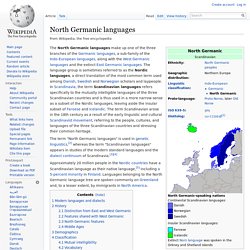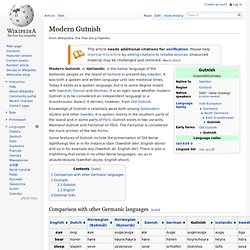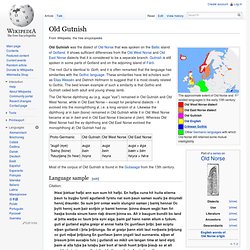Zoom
Trash

West scandinavian languages. North Germanic languages. The North Germanic languages make up one of the three branches of the Germanic languages, a sub-family of the Indo-European languages, along with the West Germanic languages and the extinct East Germanic languages.

The language group is sometimes referred to as the Nordic languages, a direct translation of the most common term used among Danish, Swedish and Norwegian scholars and laypeople. In Scandinavia, the term Scandinavian languages refers specifically to the mutually intelligible languages of the three Scandinavian countries and is thus used in a more narrow sense as a subset of the Nordic languages, leaving aside the insular subset of Faroese and Icelandic. The term Scandinavian arose in the 18th century as a result of the early linguistic and cultural Scandinavist movement, referring to the people, cultures, and languages of the three Scandinavian countries and stressing their common heritage. Modern languages and dialects[edit] The modern languages in this group are: Proto-Norse language. Proto-Norse (also Proto-Scandinavian, Primitive Norse, Proto-Nordic, Ancient Nordic, Old Scandinavian, Proto-North Germanic and North Proto-Germanic) was an Indo-European language spoken in Scandinavia that is thought to have evolved as a northern dialect of Proto-Germanic over the first centuries CE.
It is the earliest stage of a characteristically North Germanic language, and the language attested in the oldest Scandinavian Elder Futhark inscriptions, spoken ca. from the 3rd to 7th centuries (corresponding to the late Roman Iron Age and the early Germanic Iron Age). It evolved into the dialects of the Old Norse language at the beginning of the Viking Age.
Phonology[edit] Proto-Norse phonology probably did not differ substantially from that of Proto-Germanic. Although the phonetic realisation of several phonemes had probably changed over time (as with any language), the overall system of phonemes and their distribution remained largely unchanged. Consonants[edit] Vowels[edit] Accent[edit]
Modern Gutnish. Modern Gutnish, or Gotlandic, is the native language of the Gotlandic people on the island of Gotland in present-day Sweden.

It was both a spoken and written language until late medieval times. Today it exists as a spoken language, but is to some degree mixed with Swedish, Danish and German. It is an open issue whether modern Gutnish is to be considered an independent language or a Scandinavian dialect. Old Gutnish. The approximate extent of Old Norse and related languages in the early 10th century: Old West Norse dialect Old East Norse dialect Old Gutnish Old Gutnish was the dialect of Old Norse that was spoken on the Baltic island of Gotland.

It shows sufficient differences from the Old West Norse and Old East Norse dialects that it is considered to be a separate branch. The root Gut is identical to Goth, and it is often remarked that the language has similarities with the Gothic language. The Old Norse diphthong au (e.g. auga "eye") remained in Old Gutnish and Old West Norse, while in Old East Norse – except for peripheral dialects – it evolved into the monophthong ǿ, i.e. a long version of ø. Most of the corpus of Old Gutnish is found in the Gutasaga from the 13th century. Language sample[edit] Citation: Þissi þieluar hafþi ann sun sum hit hafþi.
Standardised Old Gutnish: Þissi Þieluar hafþi ann sun sum hit Hafþi. Employing normalised Old Norse orthography: Þissi Þjelvar hafði ann sun sum hít Hafði.